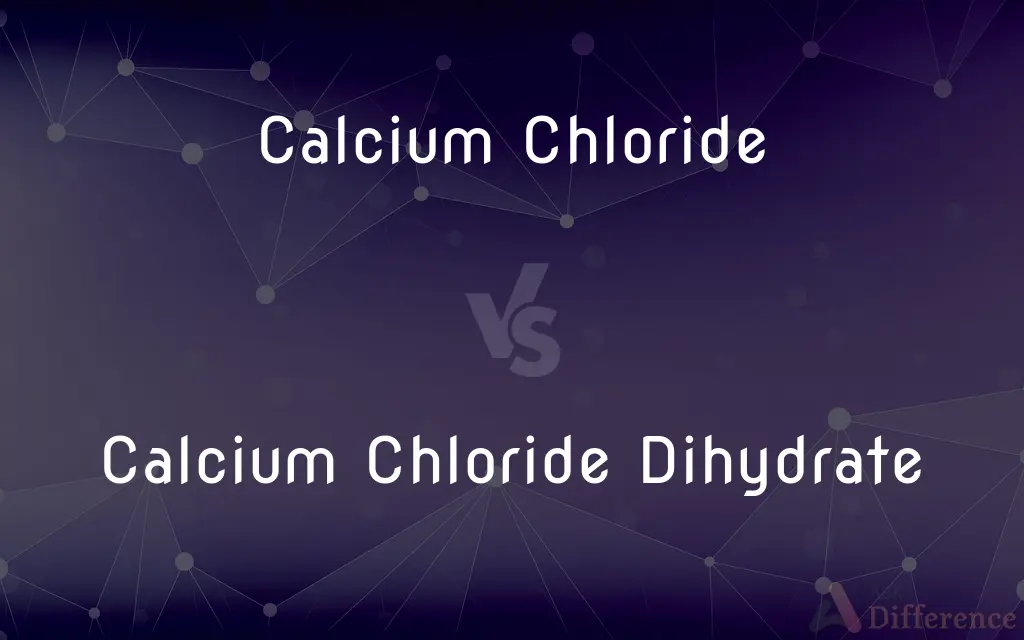Calcium Chloride vs. Calcium Chloride Dihydrate — What's the Difference?
By Tayyaba Rehman — Published on December 18, 2023
Calcium Chloride is a salt, whereas Calcium Chloride Dihydrate is the same salt but with two water molecules bound to each formula unit, affecting properties like solubility and crystallization.

Difference Between Calcium Chloride and Calcium Chloride Dihydrate
Table of Contents
ADVERTISEMENT
Key Differences
Calcium Chloride and Calcium Chloride Dihydrate are both chemically classified as salts, but they differ primarily in their water content. Calcium Chloride is anhydrous, meaning it does not contain water molecules bound to its ions. Conversely, Calcium Chloride Dihydrate includes two molecules of water as part of its chemical formula, specifically CaCl2•2H2O. This means that in addition to the calcium and chloride ions, there are water molecules integrated into its crystal structure.
Calcium Chloride, being anhydrous, has a high affinity for water and is, therefore, often used as a desiccant to absorb moisture in various applications. In contrast, Calcium Chloride Dihydrate, with its already present water molecules, has different properties and applications. The presence of water in Calcium Chloride Dihydrate impacts its physical properties, like its melting point, which is lower than that of anhydrous Calcium Chloride.
In terms of application, Calcium Chloride is widely utilized in industries such as food, construction, and road maintenance, where its ability to depress the freezing point of water is beneficial. Calcium Chloride Dihydrate, on the other hand, may be preferred in situations where the presence of water is beneficial or required, such as in certain laboratory applications or in medical uses. Thus, the choice between the two can often depend on specific application needs.
Physically, Calcium Chloride appears as white, hard fragments or flakes, while Calcium Chloride Dihydrate usually presents as a white, crystalline solid. The dihydrate form typically appears more powdery or granulated due to the water content within its crystals. Therefore, physical appearance might often be a visual clue to distinguish between Calcium Chloride and Calcium Chloride Dihydrate.
The difference in water content between Calcium Chloride and Calcium Chloride Dihydrate can significantly impact their respective behaviors, especially in solutions. Calcium Chloride is notably hygroscopic and quickly dissolves in water, releasing a lot of heat in the process. Calcium Chloride Dihydrate, however, due to its existing water molecules, may dissolve differently and exhibit a different heat of solution compared to its anhydrous counterpart.
ADVERTISEMENT
Comparison Chart
Water Content
Anhydrous (no water)
Contains two water molecules
Physical Appearance
Hard fragments or flakes
White, crystalline solid
Heat of Solution
Releases a significant amount
Lesser due to pre-existing water
Typical Uses
Desiccant, de-icing
Laboratory, medical uses
Melting Point
Higher
Lower
Compare with Definitions
Calcium Chloride
Calcium Chloride is widely utilized for de-icing purposes.
Roads are sprinkled with Calcium Chloride to prevent ice formation in winter.
Calcium Chloride Dihydrate
Calcium Chloride Dihydrate can appear as a white, crystalline solid.
The crystalline structure of Calcium Chloride Dihydrate is easily distinguishable.
Calcium Chloride
Calcium Chloride is known for its high solubility in water.
Dissolving Calcium Chloride in water produces a highly concentrated solution.
Calcium Chloride Dihydrate
Calcium Chloride Dihydrate dissolves in water, typically without excessive heat release.
Calcium Chloride Dihydrate is preferred when avoiding heat during dissolution is crucial.
Calcium Chloride
Calcium Chloride can serve as a desiccant to control humidity.
Industries use Calcium Chloride desiccants to protect moisture-sensitive products.
Calcium Chloride Dihydrate
Calcium Chloride Dihydrate consists of Calcium Chloride with two water molecules.
In labs, Calcium Chloride Dihydrate is used where stable water content is necessary.
Calcium Chloride
Calcium Chloride plays a role in food as a firming agent.
Calcium Chloride is added to canned vegetables to maintain their firmness.
Calcium Chloride Dihydrate
Calcium Chloride Dihydrate is used for various laboratory applications.
Calcium Chloride Dihydrate is essential in certain biochemistry laboratory protocols.
Calcium Chloride
Calcium Chloride is an anhydrous, hygroscopic salt.
Calcium Chloride effectively absorbs moisture in dry environments.
Calcium Chloride Dihydrate
Calcium Chloride Dihydrate typically has a lower melting point than its anhydrous counterpart.
The melting point of Calcium Chloride Dihydrate is often considered in experiments.
Common Curiosities
Is Calcium Chloride Dihydrate used in laboratories?
Yes, Calcium Chloride Dihydrate is utilized in labs due to its stable water content.
How does Calcium Chloride act as a desiccant?
Calcium Chloride absorbs moisture from the air, making it effective for controlling humidity.
What is Calcium Chloride?
Calcium Chloride is an anhydrous, hygroscopic salt, often used as a desiccant and de-icing agent.
What distinguishes Calcium Chloride Dihydrate?
Calcium Chloride Dihydrate contains two water molecules bound to each calcium chloride unit.
How does the dissolution of Calcium Chloride Dihydrate differ?
It generally dissolves without releasing excessive heat, due to its pre-existing water molecules.
Why use Calcium Chloride for de-icing?
Calcium Chloride lowers the freezing point of water, preventing ice formation on surfaces.
How do the melting points of Calcium Chloride and its dihydrate differ?
Calcium Chloride Dihydrate typically has a lower melting point than anhydrous Calcium Chloride.
Can Calcium Chloride be used in food preparation?
Yes, Calcium Chloride can be used as a firming agent in canned vegetables.
What are the general uses of Calcium Chloride in industries?
It's used as a desiccant, for de-icing, in construction, and in food processing.
Is the physical appearance of Calcium Chloride Dihydrate distinct?
Yes, it typically appears as a white, crystalline solid.
Why might one choose Calcium Chloride Dihydrate over Calcium Chloride in a lab?
The stable water content and lower heat of solution of Calcium Chloride Dihydrate may be preferable.
What happens when Calcium Chloride dissolves in water?
Calcium Chloride dissolves readily, often releasing a significant amount of heat.
Share Your Discovery

Previous Comparison
Personal Area Network vs. Local Area Network
Next Comparison
Present Simple vs. Present ContinuousAuthor Spotlight
Written by
Tayyaba RehmanTayyaba Rehman is a distinguished writer, currently serving as a primary contributor to askdifference.com. As a researcher in semantics and etymology, Tayyaba's passion for the complexity of languages and their distinctions has found a perfect home on the platform. Tayyaba delves into the intricacies of language, distinguishing between commonly confused words and phrases, thereby providing clarity for readers worldwide.
















































